More Than a DOZEN Countries Are Eager to Join BRICS
Moscow reveals how many countries want to join BRICS
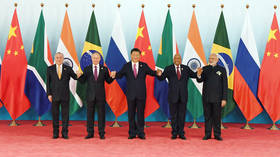
More than a dozen countries have expressed an interest in joining the BRICS group, which incorporates some of the world’s major emerging economies, as the bloc gains more global standing, Russian Foreign Minister Sergey Lavrov said on Tuesday.
Speaking at a meeting with his Indian counterpart Subrahmanyam Jaishankar, Lavrov indicated that membership of the BRICS bloc is in high demand.
“The interest in this global association is very, very high and continues to grow,” he said. He confirmed that “more than a dozen” countries are eager to join, including Algeria, Argentina, and Iran.
However, Lavrov continued, before accepting any new members, BRICS intends to reach an agreement on criteria and principles for further potential expansion.
“Given that applications are already being submitted officially, we, of course, expect that harmonization of the criteria and principles for the expansion of BRICS won’t take too long,” he said.
BRICS is an international socio-economic and political forum, which incorporates Brazil, Russia, India, China and South Africa. It accounts for over 40% of the global population and nearly a quarter of the world’s GDP.
The Russian Foreign Minister’s comments come after Algeria applied to become a member of the group, following applications by Iran and Argentina.
Algeria’s bid came after Russian President Vladimir Putin called for stronger ties with Middle Eastern and North African countries, arguing that they are playing an “increasingly significant role” in the formation of the “multipolar system of international relations.”
The bloc is also expected to consider adding Saudi Arabia, Türkey, Egypt and Afghanistan.
WHY THE UNITED STATES MUST JOIN THE BRICS
A NEW INTERNATIONAL ORDER FOR MANKIND
 a LaRouchePAC digital report
a LaRouchePAC digital report
Add your name to the list of prominent signers who are calling for the U.S. to Join the BRICS
This report serves as an outline for what is, perhaps, the best opportunity the United States has been given in decades to regain its founding identity, by joining the new international order being created at this moment by a group of leading nations to move civilization forward into a new paradigm for mankind. The planet is truly at an existential crossroads, and without a dramatic change of policy from within the United States, away from the last fourteen years of the Bush/Obama presidencies typified by Wall Street bailouts and interventionist, Cold War-style warfare, the world could very well erupt into a Third World War.
Outlined here is a mapping of the new paradigm emerging around the BRICS nations (Brazil, Russia, China, India and South Africa), how the United States can join this revolutionary new dynamic, the intellectual and political leadership provided by Lyndon and Helga LaRouche over the last forty years to make this vision a reality, and an epistomological overview of where mankind, as a species, is headed were this new paradigm to envelop the entire planet.
CONTENTS
Introduction: There Are Only Two Alternatives For MankindI. A New International Order Has EmergedII. The Imperial System Is Dead and Must Be EliminatedIII. Concrete Opportunities for the U.S. to Join the BRICSIV. A New System: Man’s Future as a Vernadskian SpeciesAppendix: LaRouche’s Role in Shaping Current History
DOWNLOAD PDF
You, the reader, have a responsibility to help bring the U.S. into this bright future. The first and easiest step, back us up: contribute to LaRouchePAC. Become a member, we are the force spearheading this fight in the United States today. Contribute $25, $50 or $100 today, work through this material, visit our events page to find an event near you, and come back regularly for updates on the BRICS and associated developments.INTRODUCTION:THERE ARE ONLY TWO ALTERNATIVES FOR MANKIND»
 a LaRouchePAC digital report
a LaRouchePAC digital report
Introduction:
There Are Only Two Alternatives for Mankind

LYNDON LAROUCHE HAS PROVIDED THE INTELLECTUAL AND POLITICAL LEADERSHIP IN THE FIGHT FOR A NEW INTERNATIONAL ECONOMIC ORDER FOR THE PLANET. THE PROFOUND IMPACT OF LAROUCHE’S LEADERSHIP IS CLEARLY REFLECTED IN THE CURRENT ACTIONS BEING TAKEN BY THE BRICS AND OTHERS TO CREATE A NEW GLOBAL FINANCIAL ARCHITECTURE AND STRATEGIC ALLIANCE AMONG NATIONS.
The following is a transcription of remarks made by Lyndon LaRouche on December 1, 2014.
The United States’ establishment under its Constitution is unique. There is nothing in the rest of the world which corresponds to the intention of the U.S. Federal Constitution. We are an entity of our own making, our own type, as contrasted with practically every other nation on the planet.
But what has happened is, there’s been a change in the process, a global change, that the United States is now, essentially, ruined by bad Presidents, especially the past two sets of Presidencies. What we need to do is return the United States to being the United States in its original Constitutional form. We don’t need to make any changes from that principle.
But now, the rest of the world is a little bit different: What you have, for example, with the role of Russia, and its relationship to the BRICS formation. What’s happened is, that large nations, and to some degree smaller ones, as opposed to Europe in general, have emerged as major forces. That is, those nations as a group, represent a power, one of the greatest powers on the planet, in terms of political power. And that power is growing. What China’s doing, for example, in terms of space, in terms of the development of the organization of the space system, within Johannes Kepler’s specifications, that’s unique.
So, we have to recognize that the United States is actually a very large part in its own right of what the new world order ought to be. But right now, we have a collection of nation-state systems which are very large, and they vastly outnumber us.
What’s happening with the British Empire’s role, is, we were creating a pseudo-world system, and that’s what the problem is. If we in the United States get rid of Obama and the Bushes and so forth, get rid of that kind of filthy government, then we can readily come into a certain kind of accord with these other nations which dominate the planet right now, which essentially are the dominant features of the planet, in Asia, in South America, and so forth.”We have to recognize that the United States is actually a very large part in its own right of what the new world order ought to be… We can readily come into a certain kind of accord with these other nations which dominate the planet right now… How are we going to take all these large entities which will largely dominate the planet, and include the United States, as a very important element of that combination of nation-states?”— Lyndon LaRouche
So therefore, what we want to do, is we want to clean up our mess at home. But we have to also find out, how are we going to relate to these BRICS-types of nations; how are we going to relate to the Russia-China agreement, and so forth; how are we going to take all these large entities which will largely dominate the planet, and include the United States, as a very important element of that combination of nation-states? And that’s what we have to do.
Therefore, we have to clean up the United States, to return it to its principle, get rid of all this stuff, like what the present Republicans seem to be doing right now—get rid of that! Get rid of Obama. Get rid of that stuff! And once we do, we simply have to reestablish the principle of the national Union.
Because we will find then, that what will happen, is we will be a relative minority on the planet, relative to the large complexes such as in South America, what will come up in Africa eventually, what will happen in Eurasia generally. And Europe, old Europe, and so forth, will be small; the United States will be a very large entity, but not the biggest entity on the planet politically or otherwise.
A NEW CONCEPTION OF SOVEREIGNTY
So we’re going to have to come to a new arrangement in which we have a new conception of what national sovereignty is. That question has not been posed clearly, as far as I can see, thus far. It’s important that we foresee where we’re going, or where we should be going. And that’s my concern. From my standpoint, I can see clearly where the United States must be going right now.
“We’re going to have to come to a new arrangement in which we have a new conception of what national sovereignty is… Because we’re going to find out that the idea of what a human being is, as opposed to an animal, which is not clear generally, yet, is going to change. What China is doing especially with the space program, is going to change the way we define the meaning of mankind.”— Lyndon LaRouche
Just simply take this new arrangement, which is not a simple sovereignty. It is something new. It is not the old notion of sovereignty. It’s a notion of a certain characteristic right of people, to have their own government, their own system, and to have these systems of government, the new systems typified by the BRICS, to come into concert with the United States under what I’ve been pushing for now: And let it flow!
Because we’re going to find that, as is shown to us by what is being done by China in its space program, in which China has taken steps into nearby space in the direction of Johannes Kepler—we’re going to find out that the idea of what a human being is, as opposed to an animal, which is not clear generally, yet, is going to change. What China is doing especially with the space program, is going to change the way we define the meaning of mankind, and a lot of other things.
A PEACEFUL REVOLUTIONARY CHANGE
So, just get ready to see those changes, folding into the system we have today. I would say that within maybe a couple of decades at least, to a couple of generations, you’ll find that the idea of what mankind is, what sovereignty is and so forth, is going to go through a revolutionary change. But it will be a peaceful revolutionary change, and a profitable one.
We just have to proceed step by step, to march in that direction, and to reach the goals which that direction points out.
“I would say that within maybe a couple of decades at least, to a couple of generations, you’ll find that the idea of what mankind is, what sovereignty is and so forth, is going to go through a revolutionary change. But it will be a peaceful revolutionary change, and a profitable one.”Lyndon LaRouche
Lyndon LaRouche also addressed this topic during a discussion which he led on November 29, 2014.
The international system as it has been heretofore, is dying, and there are only two alternatives: general thermonuclear war, or a kind of unity among nations which we see coming out of the BRICS and similar kinds of fora. In other words, the only way that you can maintain society, now, on a global scale, is on a global scale. And that means you have to affirm the fact that the nations are all working, very much as Russia and China are. The Russia-China alliance is a measure of what’s coming, and we’re just a click away from that result.
If you want to be sane, with the bankruptcy of the United States, the bankruptcy of Canada, the bankruptcy of the European nations, the Western European nations—they’re all bankrupt! And they’re never going to come out of that bankruptcy, as the kinds of nations they’ve been treated as so far.
What’s going to happen is, you’re going to have the kind of system which the BRICS represents. The world system will be, in languages and so forth, language practice and so forth, will be somewhat differentiated. But the intention, to be accomplished, of what is to be accomplished, will be more and more unified. Languages will still be used, as such, but the principle, the intention will be unified. You’re getting that tendency in South America now. It’s much stronger there than other places. The Russia-China relationship is typical of this.”You’re going to have the kind of system which the BRICS represents. The world system will be, in languages and so forth, language practice and so forth, will be somewhat differentiated. But the intention of what is to be accomplished, will be more and more unified. Languages will still be used, as such, but the principle, the intention will be unified… You will still have cultures, national cultures, which may be unique and have unique characteristics of their own, but they’ll all be part of the same kind of process which is trying to find its general unity.”
— Lyndon LaRouche
The present system, which dumb Americans believe in still, is dying, and it’s waiting to be pushed off the boards, into maybe an empty swimming tank, which would probably make a mess of things. We’re going into a new system where mankind will be a unified system, unified in practices, by means of practices which effect that.
There will be a dividing line in which the distinction is clear. You will still have cultures, national cultures, which may be unique and have unique characteristics of their own, but they’ll all be part of the same kind of process which is trying to find its general unity.
We are now saying, we’re going to a new system. Because we need to have close collaboration with our ally, China, and with other nations, which are close allies, in principle, in intention.
And gradually, we’re going to find more and more agreement, more and more integration based on the search for realization of necessary revolutions in practice. And we’re going to all be united by the principle of Johannes Kepler.
What are the BRICS countries and who are they?
- The BRICS countries, namely Brazil, Russia, India, China, and South Africa, are considered the five foremost emerging economies in the world.
BRIC Countries – Background, Key Facts, News and Original Articles
TwitterFacebookLinkedInPinterestShare
The BRIC countries label refers to a select group of four large, developing countries (Brazil, Russia, India and China). The four BRIC countries are distinguished from a host of other promising emerging markets by their demographic and economic potential to rank among the world’s largest and most influential economies in the 21st century (and by having a reasonable chance of realizing that potential). Together, the four original BRIC countries comprise more than 2.8 billion people or 40 percent of the world’s population, cover more than a quarter of the world’s land area over three continents, and account for more than 25 percent of global GDP.
BRIC Countries’ Path to 2050
A country’s population and demographics, among other factors, directly affect the potential size of its economy and its capacity to function as an engine of global economic growth and development. As early as 2003, Goldman Sachs forecasted that China and India would become the first and third largest economies by 2050, with Brazil and Russia capturing the fifth and sixth spots. The chart below shows a more recent forecast of the world ranking of the biggest economies in the year 2050. (Click on the image below to view the full-size chart in a separate tab or browser window.)
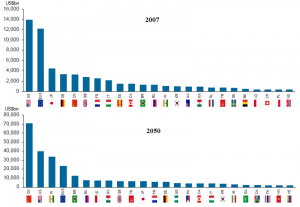
One BRIC, Two BRICs
The BRIC designation was first coined by Jim O’Neil of Goldman Sachs in a 2001 paper titled “The World Needs Better Economic BRICs.” The BRIC countries have since gone on to meet and seek out opportunities for cooperation in trade, investment, infrastructure development and other arenas. China invited South Africa to join the group of BRIC nations in December, 2010 and hosted the third annual BRICs Summit in April, 2011.
Key Indicators and Statistics
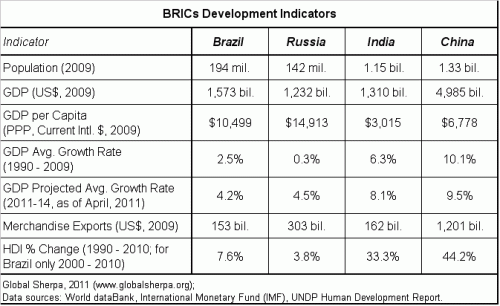
Economic Growth and Development of the BRICs
From 2000 to 2008, the BRIC countries’ combined share of total world economic output rose from 16 to 22 percent. Together, the BRIC countries accounted for 30 percent of the increase in global output during the period.
To date, the scale of China’s economy and pace of its development has out-distanced those of its BRIC peers. China alone contributed more than half of the BRIC countries’ share and greater than 15 percent of the growth in world economic output from 2000 to 2008. The chart above on key development indicators for the BRIC countries shows the sharp contrast in GDP, merchandise exports and the UNDP’s Human Development Index (HDI) between China and the other BRIC countries.
Growing BRIC Middle Class
The rapid economic growth and demographics of China and India are expected to give rise to a large middle class whose consumption would help drive the BRICs’ economic development and expansion of the global economy. The charts below depict how the increase in the middle class population of the BRIC countries is forecasted to more than double that of the developed G7 economies. (Click on the images below to view the full-size charts in separate tabs or browser windows.)
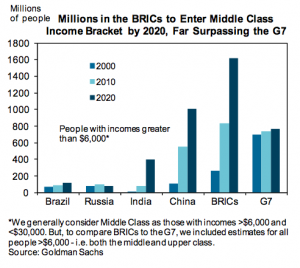
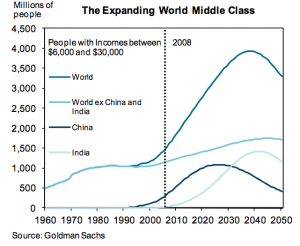
Science and Technology in the BRICs
The BRIC countries of China, India and Brazil account for much of the dramatic increase in science research investments and scientific publications. Since 2002, global spending on science R&D has increased by 45 percent to more than $1,000 billion (one trillion) U.S. dollars. From 2002 to 2007, China, India and Brazil more than doubled their spending on science research, raising their collective share of global R&D spending from 17 to 24 percent.
China’s development planning has targeted a number of scientific fields and related industries, including clean energy, green transportation and rare earths, among others. Since 1999, China’s spending on science R&D has grown 20 percent annually to more than $100 billion. By 2020, China plans to invest 2.5 percent of GDP in science research.
Next 11 Emerging Markets
Many analysts and commentators have suggested expanding the original group of four BRIC nations to include other emerging markets. Goldman Sachs has resisted conferring BRIC status on other developing countries on the grounds that their demographics and economic characteristics do not hold the potential for them to rival the economic size or influence of the BRIC countries or today’s leading economies (e.g., U.S. and Japan).
In a nod to the interest in other emerging markets, Goldman Sachs identified another group of economically dynamic and promising developing countries creatively labeled the “Next 11” in its 2005 Economics Paper No. 134 “How Solid are the BRICs?” The Next 11 consists of a broader group of emerging markets with the potential to play significant roles in the global economy, including: Bangladesh, Egypt, Indonesia, Iran, Korea, Mexico, Nigeria, Pakistan, Philippines, Turkey and Vietnam.
Mexico and South Korea
Of the Next 11, two countries, Mexico and “perhaps” South Korea, were considered to “have the capacity to become as important globally as the BRICs.” Both OECD countries were excluded from the BRIC grouping on the basis that they were already too much farther along in their economic development than the BRICs and were not likely to attain the economic stature or global influence of the original four BRIC countries.
Indonesia
Indonesia has been one of the stronger performers of the Next 11 group of developing countries. With greater than 230 million people, Indonesia’s population is more than 4 times larger than South Africa’s population and more than 60 percent bigger than Russia’s. At $540.3 billion in 2009, Indonesia’s GDP was nearly double that of South Africa, though it was still less than half the size of Russia’s economy.
South Africa
Despite China’s invitation, Goldman Sachs’ O’Neil has long contended that South Africa’s population of 50 million people, a fraction of Russia’s 143 million and China’s 1.34 billion people, is too small for BRIC status. At roughly $285 billion in 2009, South Africa’s economy was less than one quarter that of Russia’s, the smallest of the original BRIC country economies at about $1,232 billion.
Growth Environment Score (GES)
The Growth Environment Score (GES) was introduced by Goldman Sachs in the same paper that identified the Next 11. The GES is an index developed to measure the extent to which structural conditions and policy settings in a country are conducive to transforming the economic potential of the BRICs, Next 11 and other countries into reality.
The GES consists of 13 sub-indices that fall under one of five categories of economic growth determinants:
o Macroeconomic stability – inflation, government deficit and external debt
o Macroeconomic conditions – investment and openness
o Technological capabilities – penetration of phones, PCs and internet
o Human capital – average years of secondary education and life expectancy
o Political conditions – political stability, rule of law and corruption
In the original 2005 version of the GES, the scores for each of the four BRIC countries fell in the top half and above the mean of the rankings for all developing countries. On the other hand, the BRICs came in well behind more developed economies on the list of GES scores for all countries, with China ranking 53, Russia 81, Brazil 95 and India 97. Among the N-11, South Korea fared best at 17 with a score comparable to many advanced economies, followed by Mexico (59), Vietnam (63), South Africa (80), Iran (86), Egypt (91), Turkey (112), Indonesia (114), Pakistan (126), Bangladesh (134) and Nigeria (147).
Original BRIC Articles and Related Content
BRIC Country pages: Brazil, China, India (with live news feeds, country background and statistics, and links to original articles)
BRICs, Emerging Market Consumer Insights
BRIC Countries Top Survey of Green Consumers
Infrastructure Fuels Growth and Development in BRIC Countries
China in Africa: South Africa Joins BRICs Summit
China’s Development Plans Lead World, BRICs
China and India – Planning vs. Jugaad
BRIC Countries Discover Foreign Aid
Global Science Research and Collaboration
Globalization – Background, Rankings and Articles
Visit the Global Sherpa home page.TwitterFacebookLinkedInPinterestShare













